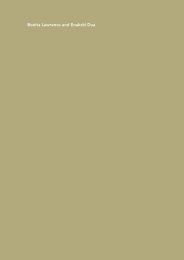Srimoyee Mitra - Speaking My Truth
Srimoyee Mitra - Speaking My Truth
Srimoyee Mitra - Speaking My Truth
- No tags were found...
You also want an ePaper? Increase the reach of your titles
YUMPU automatically turns print PDFs into web optimized ePapers that Google loves.
<strong>Srimoyee</strong> <strong>Mitra</strong>
<strong>Srimoyee</strong> <strong>Mitra</strong> is a performance artist, curator, and writer. She completed herM.A. in Art History at York University, Toronto, in 2008. Since then she developed amultidisciplinary installation entitled Let’s Talk, Get to Know Each Other Better, WeAre All Human (2008–2009) in collaboration with the Art Gallery of Ontario’s YouthCouncil. Her performance Becoming a Canadian Citizen at the AGO and ThinkingAbout Contemporary Art premiered at the Extra-Curricular: Between Art and Pedagogy(February 2010) conference at the University of Toronto and has been included at theShift: Dialogues on migration in contemporary art symposium (April 2011), McKenzieArt Gallery, Regina. Her performances have been featured in venues as diverse as CarlaGarnet Project in NightLight, Nuit Blanche (Lansdowne) in 2007, and Toronto FreeBroadcasting (September 2009) curated by Maiko Tanaka and Chris Lee. Her recentcuratorial projects include Crossing Lines: An Intercultural Dialogue (29 November2009–23 January 2010) at the Glenhyrst Art Gallery of Brant, Brantford, and ReplyAll (May 2008), an online collaborative project commissioned by SAVAC (South AsianVisual Arts Centre) and Art Metropole. <strong>Srimoyee</strong> has worked as a writer for publicationsincluding Time Out Mumbai, Art India, and The Indian Express newspaper in India.Since 2008, she has been working as the Programming Co-ordinator at SAVAC (SouthAsian Visual Arts Centre) in Toronto, where she currently lives and works.
Learning Through Crossing Lines:An Intercultural DialogueIntroductionOn 11 June 2008 I watched the live coverage of the Canadian government’sapology to the First Nations, Métis, and Inuit peoples of Canada at the AlternatorGallery for Contemporary Art in Kelowna, Territory of the Syilx Nation, in BritishColumbia. The atmosphere was charged with emotions and anticipation as Iwas seated amid national and international Indigenous and non-Indigenousmedia artists, filmmakers, cultural workers, curators, and policy-makers. Thatafternoon I felt as though I had witnessed a landmark moment in Canadianhistory. In particular, the piercing words by the president of the Native Women’sAssociation of Canada, Beverly Jacobs, stayed with me. As she accepted PrimeMinister Harper’s apology, Jacobs responded with a candid question: “Whatis it that this government is going to do in future to help our people?”1 Jacobs’sfrankness elucidated the innate dilemma of the rhetoric of moving on andbridging cultural gaps that surrounded the apology in Canada.2 She heldnot only the Canadian government, but also the entire polity accountablefor the intergenerational losses suffered by the First Peoples. I understoodJacobs’s question as a public examination of the government’s intentions: wasthe government prepared to go beyond a simplistic model of apology andforgiveness to one where the <strong>Truth</strong> and Reconciliation Commission also setforth a process of transformation that engaged in a fundamental critique ofcolonialism in Canada?3 I found it curious that the multicultural reality ofCanadian society was left out of the apology. Instead it was framed as a simplebinary relationship between European settlers (the perpetrators) apologizingand seeking forgiveness for their actions in the past from the First Nations, Métis,and Inuit peoples (the victims). While the mandate of the reconciliation processemphasized the intergenerational trauma experienced by Indian residentialschool Survivors and their families,4 it minimized the collective responsibilityof non-Indigenous people in Canada, whose foundations are also intrinsicallylinked to the Crown. Thus, by excluding more recent and multiracial immigrantperspectives from the apology, the government situated the need for initiatingthe truth and reconciliation process simply to deal with its actions in thepast. It glossed over the systemic colonial barriers that still limit the scope fordeveloping cross-cultural dialogues and collaborations among Indigenous, non-Cultivating Canada | 277
Indigenous, and immigrant communities and reinforce the disconnectionsand nonchalant attitudes of the general public.Back at the Alternator Gallery, the mood was dramatically different. Adiverse community of artists, practitioners, scholars, and organizationshad all gathered there for a four-day national conference and festival of theIndependent Media Arts Alliance. Entitled “On Common Ground,”5 theconference paid tribute to the history of Indigenous media art practices inCanada. The conference showcased the range, diversity, and complexitywithin contemporary Indigenous media art practices and highlightedthe importance of these contributions to contemporary Canadian mediaand visual art. The panel discussions and social events surrounding thesymposium facilitated formal and informal opportunities to learn, discuss,and exchange ideas, strategies, and conversations on issues relevant to mediaart practice in Canada from an Indigenous framework. The mobilization ofcross-cultural perspectives on media art practices fostered mutual respectand empathy. What the government had failed to facilitate institutionally washappening on a small-scale and grassroots level. It reinforced my belief in thepotential of contemporary art to bypass the complacency of bureaucracy andestablished structures of discrimination. The potential of cultural productionto innovate, heal, and develop alternate sites of agency and collectivitychanged my understanding of its necessity irrevocably. It led me to a profoundrealization of my intergenerational responsibility as a young artist, writer, andcurator. “On Common Ground” imagined a different Canadian society, onein which the fraught and unequal distribution of systemic advantages anddisadvantages among the settler, immigrant, and Indigenous communitieswas examined critically and its implications were reckoned with by a broadaudience. As a recent migrant from India, this conference opened my eyesto the complexities and differences of the experiences of colonialism andmarginalization experienced between a person of Indigenous backgroundsand myself, even though we shared the same name—“Indian.” It forced meto re-evaluate my role in Canadian society located between dominant Euro-American and Indigenous cultures. Do immigrants perpetuate the brutallegacy of colonialism established by European settlers when we migrateto Canada? Can Indigenous communities and immigrants work towards aframework of decolonization that transforms the social, political, and culturallandscape and empowers us to coexist peacefully along with the dominantcultures with dignity and mutual respect?South Asians and First Peoples epitomize the complexities of coexistencebetween Indigenous and non-Indigenous communities in Canada. As twocommunities that share the same name, their histories and experiences of278 | <strong>Srimoyee</strong> <strong>Mitra</strong>
“Indianness” differ widely. “Indian” isa loaded term in Canada, as it is linkedinextricably to the harmful crimescommitted by the colonial regimeto assimilate and alienate the FirstNations, Métis, and Inuit peoples inCanada with the establishment ofthe Ministry of Indian Affairs, IndianResidential Schools in 1860, andfinally the Indian Act in 1876. Thesystemic socio-economic barriers andintergenerational loss and displacementof cultures, communities, and identitiesare still pervasive within contemporaryCanadian society today. South Asiansmigrated to Canada since the earlytwentieth century as British colonialsubjects before India, Pakistan, andBangladesh had emerged as sovereignstates. They also bore the consequencesof cultural and intergenerational loss,fragmentation, and marginalizationin a fundamentally colonial and racistsociety. Over the years, the immigrationpolicy in Canada has expandeddramatically and is reflected in themulticultural reality of urban centres.According to Statistics Canada, SouthAsians constitute the largest immigrantgroup. While the presence of the SouthAsian demographic has been largelyaccepted in the mainstream popularculture, in our post-9/11 world of tightborder security and suspicion, and ofeconomic, war, and environmentalrefugees, poor immigrants continueto face discrimination on racial andsocio-economic grounds if they getin. There are parallels as well asdifferences then that exist between theideas and experiences of displacementTop, middle, and bottom installations:Afshin Matlabi, Natives (2009) (frontview); Ali Kazimi, Shooting Indians: AJourney with Jeff Thomas (rear view);and Bonnie Devine, New Earth Braid(2009). All shown in the exhibitionCrossing Lines: An InterculturalDialogue (2009–10).Cultivating Canada | 279
and marginalization, home, belonging, cultural traditions, and continuitythat shape the contemporary experience of South Asian migrants and theFirst Peoples of Canada. Yet I was surprised to find very limited scopes ofinteractivity or knowledge exchange between immigrant and Indigenouscommunities and negligible government infrastructure that facilitated suchprocesses. Consequently, I found myself thinking about the possibility ofbuilding intercultural dialogues based on the impacts of colonialism anddiscrimination between both communities. Inspired by the gathering inKelowna, I wondered if it was possible to develop events to raise awarenessand build solidarity, trust, and empathy towards one another.In 2009 I had the opportunity to curate an exhibition at the Glenhyrst ArtGallery of Brant, located next to the Six Nations of the Grand River Territoryand home to a burgeoning South Asian community. Encouraged by mytaste of an alternate society, one that was conscious and engaged, basedon Indigenous cultural values and principles at the On Common Groundconference, I hoped this experience would inform my curatorial practice. Ideveloped a thematic framework for the exhibition that was relevant to thehistory, culture, and demographic of the city and explored the possibilitiesof building mutual understanding, trust, and solidarity through crossculturaldialogues between South Asian immigrants and the First Peoplesin Canada.When I started working on this exhibition I did not know much about thecomplex histories of the Six Nations of the Grand River Territory. I wasuncomfortable speaking about the project, and, in particular, I struggledto use appropriate language that was bereft of jargon or rhetoric. Much ofmy research and what I learned took place through informal and lengthyconversations with the artists who participated in Crossing Lines: AnIntercultural Dialogue.6 As I learned about the history of Brantford andSix Nations from different Indigenous and non-Indigenous perspectives,I worked through my discomfort of being an outsider and unawareto develop a deeper understanding of Canadian history. The eventualexhibition examined the issues of connection and disconnection and sitesof intersection and divergence that exist between the so-named “Indian”communities in Canada. I invited eight artists from different Indigenousand South Asian backgrounds to explore the possibility of developing crossculturaldialogues by examining ideas of loss and displacement from theirdiverse experiences. In the next section I will discuss the artworks made byeach of the artists and their strategies for building cross-cultural dialogues.280 | <strong>Srimoyee</strong> <strong>Mitra</strong>
Jeff Thomas, A Conversation with Edward S. Curtis, #7 Medicine CrowWearing a Hawk Hide Headdress (Crow Nation c. 1908) (2009).Re-imagining IndiansWhen Indian filmmaker Ali Kazimi and Iroquois photographer Jeff Thomasstarted working on Shooting Indians: A Journey with Jeff Thomas in 1997,photography was the common language between them. In the film, Kazimitakes the viewer on an intimate journey through Jeff Thomas’s art practicewhile using an autobiographical approach that reveals Kazimi’s personalhistory as a South Asian immigrant. Most enlightening is Kazimi’s candidnarration of his own misconceptions when he had started working on thefilm, as it opens up the relatively unexamined space of dialogue betweenan immigrant and First Nations artist. Their collaboration addresses thelimitations of language and stereotypical representations that frames thepresence (and absence) of the First Peoples’ and immigrants’ experiencesin the master narrative of Canadian history. After visiting the Six Nationsof the Grand River Territory with Thomas, Kazimi notes that while his priorassumptions were unsettled after going to the reserve, he found startlingeconomic disparity and disillusionment. Kazimi acknowledges that hisconversations with Thomas enabled him to develop a deeper understandingand respect of the context of First Nations, Métis, and Inuit experiences.Meanwhile, Thomas’s ongoing engagement with the work of Edward Curtis,the twentieth century photographer and filmmaker whose artistic legacyforms the premise of the film, sets a precedent of critical inquiry into thecanons of Canadian history. Kazimi and Thomas’s dialogic approach createsa framework for questioning the existing paradigms of looking and thinkingabout personal histories. Together, they develop a sensitive portrayal ofthe contradictions of “Indianness” through the personal lens of Kazimi’sdiasporic history and Thomas’s body of work.7 Shooting Indians is an award-Cultivating Canada | 281
Animose 1: Greg Staats,Animose, 1996–ongoingwinning Canadian documentary film that challenges established formsand mediums of representing immigrant and First Peoples’ cultures. WhileCanada’s cultural landscape has changed dramatically since Kazimi and Jeffstarted working on the film in 1984, the issues of stereotypes, systemic erasure,and disconnection are still relevant.Shooting Indians: A Journey with Jeff Thomas helped me understand thestrategy of developing cross-cultural dialogues as a process of buildingtrust and mutual respect. It formed the touchstone for this exhibition. Asa next-generation immigrant and cultural practitioner, I felt that it wasimportant to highlight and revisit the discussion started by the duo in thisexhibition. In fact, the dialogic approach developed by the artists throughthe development of the film also formed one of the core principles ofThomas’s photographic practice.Crossing Lines showcases a new work from Thomas’s landmark, ongoingseries of photographs entitled A Conversation with Edward S. Curtis, in whichhe re-contextualizes images from Curtis’s 20-volume study of “The NorthAmerican Indian”8 in a contemporary context. Entitled A Conversation withEdward S. Curtis, #7 Medicine Crow Wearing a Hawk Hide Headdress (CrowNation c. 1908) (2009), Thomas assembles a triptych of three photographs:two historical portraits by Curtis of Medicine Crow dressed in ornate jewelryand a hawk carcass on his head, shot from different angles (profile andfrontal view), which flank a recent photograph of a hawk taken by Thomas ata bird sanctuary in Coaldale, Alberta. The hawk hide headdress referencesthe Indigenous practices of revering animals for their special traits. Thehawk symbolizes qualities that the bird is known for such as swiftness,agility, and precise eyesight, all of which are extremely valuable to a hunterand warrior such as Medicine Crow. Curtis’s photographs seem to capture282 | <strong>Srimoyee</strong> <strong>Mitra</strong>
Animose 2; Greg Staats,Animose, 1996–ongoingthe sitter’s pride in his cultural heritage in the slightly raised bridge ofhis nose in the profile photograph and the clarity of his direct gaze in thefrontal portrait. By placing the recent photograph of the hawk in the centre,Thomas’s triptych can be read to symbolize the importance and necessityof Indigenous knowledge systems to sustain our degraded environmenttoday. Medicine Crow also symbolizes the continuity of the various streamsof Indigenous knowledge that are part of our everyday lives and constituteour contemporary culture. By projecting Kazimi’s film in the same room,directly across from Thomas’s 16-foot-long photographic print in the gallery, Iwished to address the ongoing importance of their cross-cultural dialogue incontemporary visual art discourse today.A different form of dialogue occurs in Afshin Matlabi’s drawing Natives,where the artist explores, from an immigrant perspective, the absenceof Indigenous knowledge and subjectivities in dominant cultural history.Approaching these gaps through the lens of (mis-)representing Indigenousand immigrant people in popular culture, Matlabi portrays two figuresholding specific gestures that draw the viewer’s attention into the work. Thefigure on the right-hand side of the drawing is shown with one arm aboveher head holding a pose from the Indian classical dance, Bharatanatyam,where stylized hand gestures or mudras constitute an integral part of thedance vocabulary. By portraying the figure without her traditional costume,Matlabi resists the viewer’s easy categorization and simplistic conclusionsabout the dancer’s cultural identity. The figure beside her holds an openhandedgesture, which can be understood as a symbol of friendship andpeace among some First Peoples. It can also be read as a universal signalto stop, perhaps alluding to the marginalization of both immigrant andIndigenous communities by the patronizing gaze of the dominant culture.The title of the work Natives also refers to the common and disparate historiesCultivating Canada | 283
and intergenerational traumas of colonization experienced by South Asianand Indigenous communities. Using pencil and ink on paper, Matlabi fillsthe background of his large-scale drawing with countless, multidirectionalstrokes. In particular, the erratic, bold flow of the strokes between thefigures draws the viewer’s attention, as they seem to break the linear flowof colour in the rest of the drawing. I understand these multidirectionalstrokes to symbolize a need to disturb the established ideas and assumptionsshaping South Asian and Indigenous identities and cultures in thedominant narrative. The distance between the figures, holding specific andseemingly disconnected poses, can be understood as the artist’s attempt toacknowledge the complexities surrounding Indigenous and migrant relationsin Canada. Meanwhile, reflecting upon the brutal historical similaritiesof exoticization and fetishization of Indigenous and South Asian culturesby the colonial gaze, Matlabi’s foregrounding of the figure referencing anIndigenous gesture demonstrates his plea to reframe the dominant culturalnarrative from an Indigenous framework.Reframing the gaze is also central to Ojibway artist Bonnie Devine, whoexplores the intricacies of the relations between Indigenous and non-Indigenous communities metaphorically. New Earth Braid is made up ofreeds gathered from the banks of the Grand River in Six Nations and theoutskirts of Brantford, which are used to create a 12-foot-long braid thatrepresents the oral histories, cultures, and traditions of the First Peoplesthat are woven into the land. Through these simple reeds, Devine referencesthe undocumented histories of Indigenous knowledge systems and the FirstPeoples’ spirit of collaboration that has enabled migrants and settlers tosurvive and thrive in a foreign land. In contemporary society, the gesture ofbraiding signifies various traditions associated with women’s work such asbasket weaving, an Elder braiding a child’s hair, and the adolescent practiceof making friendship bands. In my conversations with the artist, I havelearned that Devine also associates the New Earth Braid with the Councilof Three Fires and her cultural heritage regarding the work as embodyingvalues of diligence, compassion, and courage as the basis for cross-culturaldiscussions to succeed.Roy Caussy examines the multiple and incomplete narratives that makeup the canonical accounts of Canadian history. He creates rubbings ofthree plaques that commemorate three of the most significant momentsof Brantford’s history: The Haldimand Proclamation of 1784, The MohawkInstitute Residential School that was established in 1831 and closed in the1970, and the founding of the town of Brantford in 1877. Each plaque presentsa distinctly different perspective and approach of the history and culture284 | <strong>Srimoyee</strong> <strong>Mitra</strong>
of the region. By bringing them together within one gallery, Caussy simplyelucidates the socio-economic, cultural, and political disparities that persistwithin contemporary Canadian culture. He juxtaposes these deep-rootedchasms with a melodic sound installation, in which he has recorded voicesof strangers he has encountered on the streets of Brantford, to develop aresonant harmony that is made up of multiple voices and programmedto play every seven minutes. Every time the sound piece is turned on, itfills the gallery with a sense of familiarity and intimacy. In Three-partHarmony (2009), Caussy highlights the severe need to reinvent and reworkthe simplistic dominant discourse that perpetuates the alienation andmarginalization of Indigenous people and newcomers in the mainstream.Ottawa-based Ehren Bear Witness Thomas subverts the colonizing masternarratives in popular culture in his invigorating videowork StrangeHomelands: Part Two. Reflecting on the narcissism and the disconnection ofour over-saturated consumer culture with multiple histories and paradigmsof viewing, listening, and understanding, Thomas layers and samplespersonal footage with scenes from Hollywood films, Disney cartoons, popmusic, and video games. He challenges linear and polarizing frameworksin the mainstream through his dynamic media art practice, based on hispersonal Indigenous subjectivities. Thomas’s video emanates a sense ofurgency to refute totalizing narratives and to shift the accepted masternarrative of North American history and culture to one that is based onideologies of social justice, freedom, and peace.Meanwhile, Yudi Sewraj of Guyanese and South Asian heritage expands onthe notions of loss, displacement, and doubt in the dominant cultural historyin his video installation Nineteen Seventy-Eight (2009). The installation ismade up of three major components: two sets of videos, one playing onold-school TV monitors and the other projected on the wall, placed onopposite sides of an opaque wooden crate and making it impossible for theviewer to experience the entire installation at once. Nineteen Seventy-Eightdraws attention to the spatial and temporal elements of the work, openingit up to multiple subjectivities and responses. There are peepholes ondifferent sides of the crate that enable the audience to look inside and findan abandoned couch. The videos, which display a running loop of foundhousehold objects being destroyed and swept away, seem to draw parallelswith the loss of multiple narratives and histories that have been erased bythe master narrative. In the video projection, Sewraj inverts the viewer’sgaze onto himself, as he performs in it. Using a mimetic strategy to critiqueaccepted paradigms and practices of everyday life, a sense of discomfort andalienation is palpable in Sewraj’s absurd attempts to replicate the mundaneCultivating Canada | 285
actions of an old man that plays on a monitor inside the video. The videowithin a video further breaks down any sense of origin or authenticity thatmight legitimize the prevailing colonial master narrative that has repeatedlyled to the violent intergenerational losses of language, culture, and traditionssuffered by immigrant and Indigenous populations.The experience of loss and dislocation also informs Ohsweken artist GregStaats’s ongoing series of black and white photographs entitled Animose.Staats embarked upon this series in 1996, a decade after he moved to Toronto,as a way of coping with the loss of his sense of belonging. The etymologyof the word Animose comes from anima, meaning “breath” or “discreetpresence,” which personifies Staats’s exploration of discarded objectsthrough his photographs. By privileging their presence in the urban-scapethrough his photographs, this series provides an alternate understanding ofCanadian cities and lifestyles that links his personal experiences with foundand forgotten objects he encounters on the street, bus stops, and parks. Someexamples include: two carpets lying on the curb, a mound of dirt heaped onthe sidewalk and street, a chair sitting across a log camouflaged betweentree trunks, and two bundles of sticks flung out on the street. Each of thesephotographs exude a strong presence and balance in their new settings.The photographs embody the serenity and vitality of oral traditions andknowledge systems that have been intrinsic to the development of Canadianculture. They also symbolize the importance of acknowledging the presenceof oral traditions, ceremonies, and symbols of First Nations, Métis, and Inuitcultures and experiences in Canada as the first steps toward building crossculturaldialogues and trust with immigrant and settler communities.Steps toward the futureIn her analysis of the current reconciliation discourse, researcher and scholarPaulette Regan has said, “we remain stuck in a mindset of denial and guiltabout past wrongs in which we problematize and pathologize Indigenouspeoples, seeking legal and bureaucratic solutions to a long list of ‘Indianproblems’ and ‘historical’ ‘claims.’ In doing so, we deflect attention away fromthe ‘Settler problem,’ [and] our own complicity in maintaining the colonialstatus quo.”9 Critiquing the biases latent in the institutionalized structures ofcross-cultural interactivity, Regan holds the willingness of non-Indigenouscommunities to engage with the narratives revealed through the <strong>Truth</strong> andReconciliation Commission equally responsible in developing an effectiveframework that builds awareness and destabilizes the colonial mindsetof the dominant culture. Cross-cultural dialogues can provide a commonspace for self-reflexivity, listening, and learning from the multiple histories,286 | <strong>Srimoyee</strong> <strong>Mitra</strong>
experiences, and narratives that remain unheard of in the mainstream.Through his series of photographic works, Greg Staats acknowledges thatthese Indigenous subjectivities must be the starting point of any form ofcross-cultural dialogue. The dialogic approach, facilitated at the small-scaleand grassroots level, becomes crucial in overcoming the government’ssuperficial apology that has failed to acknowledge the devastating impact ofpast injustices that continue into the present. For newcomers to Canada, inparticular, such opportunities can facilitate an effective way in understandingthe complexities of Canadian histories, which will lead to nuanced ways ofengaging with contemporary Canadian culture.Altogether, the artworks exhibited in Crossing Lines: An Intercultural Dialogueattempt to disturb the dominant cultural history that “‘misrecognizes’ anddisrespects [and denies] the oral histories, cultures, and legal traditions ofIndigenous peoples.”10 Emerging from a minoritarian perspective, immigrantand Indigenous subjectivities of the artists are based on notions of loss anddisplacement, which form the starting point for building cross-culturaldialogues through the exhibition. Such a perspective challenges the colonialmindset and hegemonic narratives of a national history that legitimize thedisparities and socio-economic privileges that exist between Indigenous,immigrant, and settler communities. Exploring the possibility of dialoguesalso provides artists (and myself) with an opportunity to re-imaginecontemporary Canadian society based on ideas of collectivity, community, andmutual respect.In retrospect, Crossing Lines: An Intercultural Dialogue was an enlighteningexperiment, a meaningful exercise, and the beginning of my exploration onthe strategies of learning through dialogue and collaboration. In the processI learned about my own discomfort while working on and researching theconcepts for this exhibition, with a heightened awareness of my limitedknowledge of the complex histories, narratives, and traditions of diverseIndigenous communities and nations. I realized that my role and responsibilityas a recent immigrant in Canada was in a constant state of flux, as it shiftedbetween being a beneficiary, thus perpetrator, of the colonial socio-economicprivileges of the dominant framework—benefiting from incentives providedto middle-class and educated immigrants for instance—on the one hand, andon the other, being vulnerable to the discriminatory and unquestionable lawsof the same structures. I learned how to speak from my position of knowingand not knowing with humility and honesty as I engaged in dialogues withthe accomplished and emerging artists in the exhibitions, many of whom hada strong grasp of creating collaborative and collective strategies to developmutual trust and respect. This exhibition, in its small-scale and localizedCultivating Canada | 287
context, sought to build an ethos of communication that recognized thestruggles within Indigenous and immigrant communities and to buildsolidarity on a personal and human level.Notes1 Jacobs, B. (2008:6857). Canada. Parliament. House of Commons Debates (Hansard).39th Parliament, 2nd Session, Vol. 142, No. 110 (June 11, 2008). Ottawa, ON: PublicWorks and Government Services Canada. Retrieved 7 December 2010 from: http://www2.parl.gc.ca/HousePublications/Publication.aspx?Language=E&Mode=1&Parl=39&Ses=2&DocId=3568890.2 Clark, T. and R. de Costa (2009). A Tale of Two Apologies. Canada Watch. Fall 2009:36–37,40. Retrieved 8 December 2010 from: http://www.yorku.ca/robarts/projects/canada-watch/3 Regan, Paulette (2007). An apology feast in Hazelton: Indian residential schools,reconciliation, and making space for Indigenous legal traditions. In Law Commissionof Canada (ed.). Indigenous Legal Traditions. Vancouver, BC:UBC Press: 40–76.4 de Costa, Ravi (2009). <strong>Truth</strong>, Reconciliation and the Politics of Community: ThePolitics of Community and Identity: Learning from one another. University of Ottawa(May 20–22, 2009). Retrieved 25 November 2010 from: http://www.sciencessociales.uottawa.ca/communities09/en/discussion.asp5 The On Common Ground conference took place between 10–15 June 2008, andwas organized in partnership with the Ullus Collective, an Indigenous Media ArtsCollective from the region, and the Alternator gallery in Kelowna, BC.6 Crossing Lines: An Intercultural Dialogue was co-presented by SAVAC (South AsianVisual Arts Centre) and the Glenhyrst Art Gallery of Brant from 29 November 2009–22January 2010. The exhibition took place at the Glenhyrst Art Gallery of Brant inBrantford, Ontario.7 Francis, Margot (2002). Reading the autoethnographic perspectives of Indians‘Shooting Indians.’ Topia 7:5–26. Francis first attributes the term “Indianness” on p.11. For further discussion on this term see: Lyman, Christopher (1982). The VanishingRace and Other Illusions: Photographs of lndians by Edward Curtis. New York, NY:Pantheon Books in association with the Smithsonian Institution Press.8 Thomas’s research at the National Archives revealed that when Curtis made theseportraits, most of the First Peoples had lost their traditional livelihoods of huntingand fishing. Many were even banned from practising their songs, dances, andcarrying out cultural practices. So, when Curtis took these photos, it gave the sittersan opportunity to dress in their cultural heritage that was being denied them by thecolonial regime.9 Regan (2007:44) [reference in original removed].10 Regan, Paulette (2007:43).288 | <strong>Srimoyee</strong> <strong>Mitra</strong>
















